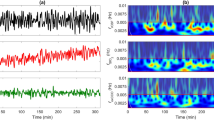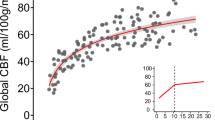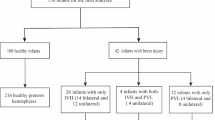Abstract
Disturbances in cerebral blood flow (CBF) are a major factor in the etiology and pathogenesis of cerebral damage in the neonate. As most animals are more mature at birth than man, extrapolation from animal studies to the human is questionable. Therefore, we have measured regional CBF (rCBF) in preterm infants. rCBF flow was measured in 12 normotensive and normoxic preterm infants [mean birth weight 915 g (range 550 to 2680 g), mean gestational age 27.7 wk (25 to 32 wk)]. All infants had a normal cerebral ultrasound examination. rCBF was measured using a mobile brain dedicated fast-rotating four-head multidetector system specially designed for neonatal studies. The tracer was 99mTc-labeled D,L-hexamethylpropylenamine oxime in a dose of 4 Mbq/kg. rCBF of the subcortical white matter was 0.53(0.48-0.58) of the global CBF. After correction for scattered radiation, the estimate of rCBF to the white matter was reduced to 0.39 (0.36-0.42). The flow to the basal ganglia was 2.33 (2.08-2.59) times the global CBF. After correction for partial volume effect, the cortical flow was higher than the flow to the basal ganglia and highest in the frontotemporal cortex (motor cortex). The flow to the cerebellum was of the same magnitude as the flow to the basal ganglia, but with a significantly higher variation. rCBF in 12 preterm infants showed a flow distribution similar to flow in other newborn mammals. The gray-white matter contrast, however, was greater. This new information, combined with existing data showing low global CBF, suggests that blood flow to the white matter in the preterm human neonate is extremely low.
Similar content being viewed by others
Log in or create a free account to read this content
Gain free access to this article, as well as selected content from this journal and more on nature.com
or
Abbreviations
- CBF:
-
cerebral blood flow
- rCBF:
-
regional cerebral blood flow
- SPECT:
-
single photon emission computer tomography
- FWHM:
-
full-width at half-maximum
- HMPAO:
-
D,L-hexamethylpropylenamine oxime
- ROI:
-
region of interest
References
Lou HC, Lassen NA, Friis-Hansen B 1979 Impaired autoregulation of cerebral blood flow in the distressed newborn infant. J Pediatr 94: 118–121
Milligan DWA 1980 Failure of autoregulation and intraventricular haemorrhage in preterm infants. Lancet 8174: 896–898
Vanucci RC 1993 Experimental models of perinatal hypoxic-ischemic brain damage. APMIS Suppl 40: 101:8989-95
Lou HC, Lassen NA, Friis-Hansen B 1977 Low cerebral blood flow in hypotensive perinatal distress. Acta Neurol Scand 56: 343–352
Greisen G 1986 Cerebral blood flow in preterm infants during the first week of life. Acta Paediatr Scand 75: 43–51
Volpe JJ, Herscovitch P, Perlman JM, Raichle ME 1983 Positron emission tomography in the newborn: extensive impairment of regional cerebral blood flow with intraventricular hemorrhage and hemorrhagic intracerebral involvement. Pediatrics 72: 589–601
Younkin D, Delivoria-Papadopoulos M, Reivich M, Jaggi J, Obrist W 1988 Regional variations in human newborn cerebral blood flow. J Pediatr 112: 104–108
Fockele DS, Baumann RJ, Shih W, Ryo U 1990 Tc-99m HMPAO SPECT of the brain in the neonate. Clin Nucl Med 15: 175–177
Denays R, Pachterbeke TV, Tondeur M, Spehl M, Toppet V, Ham H, Piepz A, Rubinstein M, Noël P, Haumont D 1989 Brain single photon emission computed tomography in neonates. J Nucl Med 30: 1337–1341
Chiron C, Raynard C, Mazière B, Zilbovicius M, Laflamme L, Masure M, Dulac O, Bourguignon M, Syrota A 1992 Changes in regional cerebral blood flow during brain maturation in children and adolescents. J Nucl Med 33: 696–703
Park CH, Spitzer AR, Desai HJ, Zhang JJ, Graziani LJ 1992 Brain SPECT in neonates following extracorporeal membrane oxygenation: evaluation of technique and preliminary results. J Nucl Med 33: 1943–1948
Haddad J, Constantinesco A, Brunot B, Messer J 1994 A study of cerebral perfusion using single photon emission computed tomography in neonates with brain lesions. Acta Paediatr 83: 265–269
Haddad J, Constantinesco A, Brunot B, Messer J 1994 Cerebral perfusion studies during maturation using single photon emission computed tomography in the neonatal period. Biol Neonate 65: 281–286
Konishi Y, Kuriyama M, Mori I, Fujii Y, Konishi K, Sudo M, Ishii Y 1994 Assessment of local cerebral blood flow in neonates withN-isopropyl-p-[123I]iodoamphetamine and single photon emission computed tomography. Brain Dev 16: 450–453
Baenziger O, Jaggi JL, Mueller AC, Morales CG, Lipp AE, Duc G, Bucher H 1995 Regional differences of cerebral blood flow in the preterm infant. Eur J Pediatr 154: 919–924
Vestergren E, Jacobsson L, Mattson S, Johansson L, Bjure J, Sixt R, Uvebrandt P 1992 Biokinetics and dosimetri of Tc-99m HM-PAO in children. In: Watson EE, Schlafkestelson AT (eds) Proceedings of Fifth International Radiopharmaceutical Symposium. US Department of Commerce, National Technical Information Service, Washington DC, pp 443
Borch K, Greisen G 1997 HMPAO as a tracer of cerebral blood flow in newborn infants. J Cereb Blood Flow Metab 17: 448–54
Jazsczak RJ, Greer KL, Floyd CE, Harris CC, Coleman RE 1984 Improved SPECT quantification using compensation for scattered photons. J Nucl Med 25: 893–900
Børch K 1996 Quantification of regional cerebral blood flow in preterm infants. Dissertation, University of Copenhagen, pp 67–76
McArdle CB, Richardson CJ, Nicholas DA, Mirfakhraee M, Hayden CK, Amparo EG 1987 Developmental features of the neonatal brain: MR imaging. Part I. Gray-white matter differentiation and myelination. Radiology 162: 223–229
Rottenberg DA, Moeller JR, Strother, Dhawan V, Sergi ML 1991 Effects of percent thresholding on the extraction of[18F]fluorodeoxyglocose positron emission tomographic region-of-interest data. J Cereb Blood Flow Metab 11: A83–88
Sobotta J, Becher H 1967 Atlas der Anatomie des Menschen. 3. Teil, 16 Ed. Urban & Schwarzenberg, Berlin, pp 312
Hoffman EJ, Huang S, Phelps ME 1979 Quantitation in positron emission computed tomography. 1. Effect of object size. J Comput Assisted Tomogr 3: 299–308
Rabinowicz T 1964 The cerebral cortex of the premature infant of the 8th month. Prog Brain Res 4: 39–86
Greisen G, Trojaborg W 1987 Cerebral blood flow, PaCO2 changes and visual evoked potentials in mechanically ventilated, preterm infants. Acta Pediatr Scand 76: 394–400
Altman DI, Powers WJ, Perlman JM, Herscovitch P, Volpe SL, Volpe JJ 1988 Cerebral blood flow requirements for brain viability in newborn infants is lower than in adults. Ann Neurol 24: 218–226
Cavazzuti M, Duffy TE 1982 Regulation of local cerebral blood flow in normal and hypoxic newborn dogs. Ann Neurol 11: 247–257
Young RSK, Hernandez MJ, Yagel SK 1982 Selective reduction of blood flow to white matter during hypotension in newborn dogs: a possible mechanism of periventricular leucomalacia. Ann Neurol 12: 445–448
Toft PB, Leth H, Ring PB, Peitersen B, Lou HC, Henriksen O 1995 Volumetric analysis of the normal infant brain and in intrauterine growth retardation. Early Hum Dev 43: 15–29
Chugani HT, Phelps ME, Maziotta JC 1987 Positron emission tomography study of human brain functional development. Ann Neurol 22: 487–497
Greisen G, Frederiksen PS, Mali J, Friis-Hansen B 1984 Analysis of cranial 133-xenon clearance in the newborn infant by the two-compartment model. Scand J Clin Lab Invest 44: 239–250
Syed GMS, Eagger E, Toone BK, Levy R, Barrett JJ 1992 Quantification of regional cerebral blood flow (rCBF) using 99mTc-HMPAO and SPECT: choice of reference region. Nucl Med Commun 13: 811–816
Shapiro HM, Greenberg JH, Van Horn Naughton K, Reivich M 1980 Heterogeneity of local cerebral blood flow-PaCO2 sensitivity in neonatal dogs. J Appl Physiol 49: 113–118
Reuter JH, Disney TA 1986 Regional cerebral blood flow and cerebral metabolic rate of oxygen during hyperventilation in the newborn dog. Pediatr Res 20: 1102–1106
Ashwal S, Dale PS, Longo LD 1984 Regional cerebral blood flow: studies in the fetal lamb during hypoxia, hypercapnia, acidosis and hypotension. Pediatr Res 18: 1309–1316
Goplerud JM, Wagerle LC, Delivoria-Papadopoulos M 1989 Regional cerebral blood flow response during and after acute asphyxia in newborn piglets. J Appl Physiol 66: 2827–2832
Pasternak JF, Groothuis DR, Fischer JM, Fischer DP 1982 Regional cerebral blood flow in the newborn beagle pup: the germinal matrix is a low-flow structure. Pediatr Res 16: 499–503
Young RSK, Yagel SK 1984 Cerebral physiological and metabolic effects of hyperventilation in the neonatal dog. Ann Neurol 16: 337–342
Ment LR, Stewart WB, Gore JC, Duncan CC 1988 Beagle puppy model of perinatal asphyxia: alterations in cerebral blood flow and metabolism. Pediatr Neurol 4: 98–104
Mujsce DJ, Christensen MA, Vanucci RC 1989 Regional cerebral blood flow and glucose utilization during hypoglycemia in newborn dogs. Am J Physiol 256:H1659–H1666
Author information
Authors and Affiliations
Additional information
Supported by The AP Møller and Chastine Mc-Kinney Møller Foundation.
Rights and permissions
About this article
Cite this article
Børch, K., Greisen, G. Blood Flow Distribution in the Normal Human Preterm Brain. Pediatr Res 43, 28–33 (1998). https://doi.org/10.1203/00006450-199801000-00005
Received:
Accepted:
Issue date:
DOI: https://doi.org/10.1203/00006450-199801000-00005
This article is cited by
-
Endothelial colony forming cell administration promotes neurovascular unit development in growth restricted and appropriately grown fetal lambs
Stem Cell Research & Therapy (2023)
-
Contrast-enhanced ultrasound of the neonatal brain
Pediatric Radiology (2022)
-
Positron Emission Tomography/Magnetic Resonance Hybrid Scanner Imaging of Cerebral Blood Flow Using15O-Water Positron Emission Tomography and Arterial Spin Labeling Magnetic Resonance Imaging in Newborn Piglets
Journal of Cerebral Blood Flow & Metabolism (2015)
-
Diffusion magnetic resonance imaging in preterm brain injury
Neuroradiology (2013)
-
The premature brain: developmental and lesional anatomy
Neuroradiology (2013)



